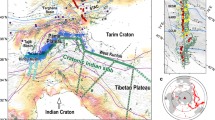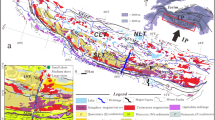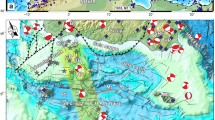Abstract
‘Subduction erosion’ has been invoked to explain material missing from some continents along convergent margins1. It has been suggested that this form of tectonic erosion removes continental material at the front of the margin or along the underside of the upper (continental) plate2,3,4. Frontal erosion is interpreted from disrupted topography at the base of a slope and is most evident in the wake of subducting seamounts5,6. In contrast, structures resulting from erosion at the base of a continental plate are seldom recognized in seismic reflection images because such images typically have poor resolution at distances greater than ∼ 5 km from the trench axis. Basal erosion from seamounts and ridges has been inferred7,8, but few large subducted bodies—let alone the eroded base of the upper plate—are imaged convincingly. From seismic images we identify here two mechanisms of basal erosion: erosion by seamount tunnelling and removal of large rock lenses of a distending upper plate. Seismic cross-sections from Costa Rica to Nicaragua indicate that erosion may extend along much of the Middle America convergent margin.
This is a preview of subscription content, access via your institution
Access options
Subscribe to this journal
Receive 51 print issues and online access
$199.00 per year
only $3.90 per issue
Buy this article
- Purchase on Springer Link
- Instant access to full article PDF
Prices may be subject to local taxes which are calculated during checkout




Similar content being viewed by others
References
Rutland,R. W. R. Andean orogeny and ocean floor spreading. Nature 233, 252–255 (1971).
Murauchi,S. & Ludwig,W. J. Crustal structure of the Japan trench: The effect of subduction of ocean crust. Init. Rep. DSDP 56-57 (part 1), 463–470 ( 1980).
Scholl,D. W., von Huene,R., Vallier,T. L. & Howell,D. G. Sedimentary masses and concepts about tectonic processes at underthrust ocean margins. Geology 8, 564– 568 (1980).
von Huene, R. & Scholl, D. W. Observations at convergent margins concerning sediment subduction, subduction erosion, and the growth of continental crust. Rev. Geophys. 29, 279– 316 (1991).
Lallemand,S. & Le Pichon,X. Coulomb wedge model applied to the subduction of seamounts in the Japan Trench. Geology 15, 1065–1069 (1987).
Collot,J. Y. & Fisher,M. A. Formation of forearc basins by collision between seamounts and accretionary wedges: An example from the New Hebrides subduction zone. Geology 17, 939 –933 (1989).
Ballance,P. F. et al. Subduction of a large Cretaceous seamount of the Louisville ridge at the Tonga Trench: A model of normal and accelerated tectonic erosion. Tectonics 8, 953–962 (1989).
Le Pichon,X., Henry,P. & Lallemant, S. Accretion and erosion in subduction zones: The role of fluids. Annu. Rev. Earth Planet. Sci. 21, 307–331 (1993).
Hinz,K., von Huene,R., Ranero,C. R. & PACOMAR working group. Tectonic structure of the convergent Pacific margin offshore Costa Rica from multichannel seismic reflection data. Tectonics 15, 54– 66 (1996).
Kimura,G. et al. Init. Rep. ODP 170 (1997).
Ranero,C. R. et al. A cross section of the Pacific Margin of Nicaragua. Tectonics (in the press).
Stavenhagen,A. U. et al. Seismic wide-angle investigations in Costa Rica—a crustal velocity model from the Pacific to the caribbean Coast. Zbl. Geol. Paläeontol. 1, 393–408 (1998).
Walther,C. H. E., Flueh,E. R., Ranero,C. R., von Huene,R. & Strauch,W. Crustal structure across the Pacific Margin of Nicaragua—evidence for ophiolitic basement and a shallow mantle sliver. Geophys. J. Int. (in the press).
von Huene,R., Ranero,C. R., Weinrebe,W. & Hinz,K. Quaternary convergent margin tectonics of Costa Rica, segmentation of the Cocos Plate, and Central American volcanism. Tectonics (in the press).
Scholz,C. H. & Small,C. The effect of seamount subduction on seismic coupling. Geology 25, 487– 490 (1997).
Wang,W. & Scholz,C. H. Wear processes during frictional sliding of rock: A theoretical and experimental study. J. Geophys.Res. 99, 6789–6799 ( 1994).
Protti,M., Güendel,F. & McNally, K. in Geologic and Tectonic Development of the Caribbean Plate Boundary in Southern Central America (ed. Mann, P.) (Special Paper 295, Geological Society of America, Boulder, Colorado, 1995 ).
McIntosh,K., Silver,E. & Shipley,T. Evidence and mechanisms for forearc extension at the accretionary Costa Rica convergent margin. Tectonics 12, 1380–1392 (1993).
Shipley,T. H., McIntosh,K. D., Silver,E. A. & Stoffa,P. L. Three-dimensional seismic imaging of the Costa Rica accretionary prism: Structural diversity in a small volume of the lower slope. J. Geophys. Res. 97, 4439–4459 ( 1992).
Vrolijk,P. On the mechanical role of smectite in subduction zones. Geology 18, 703–707 ( 1990).
Hilde,T. W. C. Sediment subduction versus accretion around the Pacific. Tectonophysics 99, 381–397 ( 1983).
Aubouin,J. et al. Leg 84 of the deep drilling project:subduction without accretion: Middle America Trench off Guatemala. Nature 297, 458–460 (1982).
Ye,S. et al. Crustal structure of the subduction zone off Costa Rica derived from OBS refraction and wide-angle reflection seismic data. Tectonics 15, 1006–1021 ( 1996).
Mackay,S. & Abma,R. Depth focusing analysis using wavefront-curvature criterion. Geophysics 58, 1148– 1156 (1993).
Acknowledgements
We thank T. Reston for comments on the manuscript. SONNE-81 seismic reflection data were collected by the BGR.
Author information
Authors and Affiliations
Corresponding author
Rights and permissions
About this article
Cite this article
Ranero, C., von Huene, R. Subduction erosion along the Middle America convergent margin. Nature 404, 748–752 (2000). https://doi.org/10.1038/35008046
Received:
Accepted:
Issue Date:
DOI: https://doi.org/10.1038/35008046
This article is cited by
-
Trench-parallel ridge subduction controls upper-plate structure and shallow megathrust seismogenesis along the Jalisco-Colima margin, Mexico
Communications Earth & Environment (2023)
-
Evolution of the geological structure and mechanical properties due to the collision of multiple basement topographic highs in a forearc accretionary wedge: insights from numerical simulations
Progress in Earth and Planetary Science (2022)
-
A strength inversion origin for non-volcanic tremor
Nature Communications (2022)
-
Hadal aragonite records venting of stagnant paleoseawater in the hydrated forearc mantle
Communications Earth & Environment (2021)
-
Localized extension in megathrust hanging wall following great earthquakes in western Nepal
Scientific Reports (2021)
Comments
By submitting a comment you agree to abide by our Terms and Community Guidelines. If you find something abusive or that does not comply with our terms or guidelines please flag it as inappropriate.



